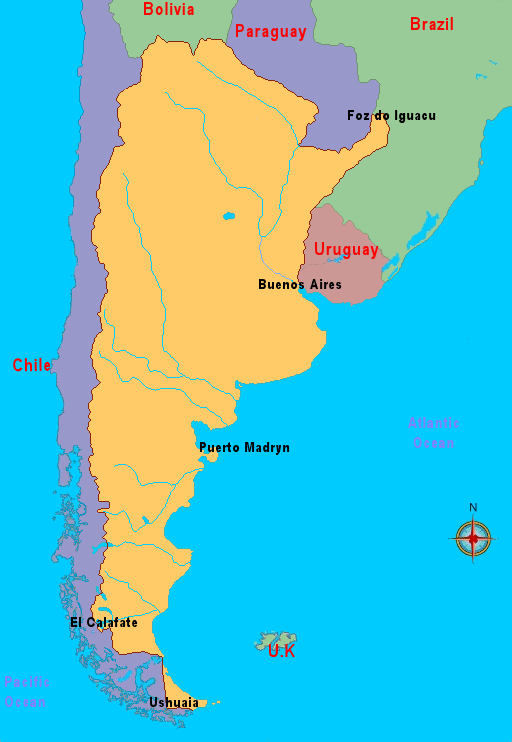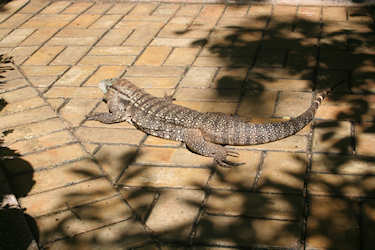Argentina

Historie
Until the period of European colonization, Argentina was relatively sparsely populated by a wide number of diverse cultures with
different social organizations, which can be divided into three main groups.
The first group are basic hunters and food gatherers without development of pottery, such as the Selk'nam and Yamana
in the extreme south.
The second group are advanced hunters and food gatherers which include the Puelche, Querandí and Serranos in
the center-east; the Tehuelche in the south and the Kom and Wichi in the north.
The last group are farmers with pottery, like the Charrúa, Minuane and Guaraní in the northeast, with slash and
burn semisedentary existence; the advanced Diaguita sedentary trading culture in the northwest; the Toconoté and
Hênîa and Kâmîare in the country's center, and the Huarpe in the center-west, a culture that raised llama
cattle and was strongly influenced by the Incas.
Europeans first arrived in the region with the 1502 voyage of Amerigo Vespucci.
The Spanish Empire subordinated the economic potential of the Argentine territory to the immediate wealth of the silver and gold mines
in Bolivia and Peru, and as such it became part of the Viceroyalty of Peru until the creation of the Viceroyalty of the
Río de la Plata in 1776 with Buenos Aires as its capital.
The Argentine War of Independence (1810–1818) was followed by an extended civil war that lasted until 1861, culminating in
the country's reorganization as a federation of provinces with Buenos Aires as its capital city.
The country thereafter enjoyed relative peace and stability, with massive waves of European immigration radically reshaping its
cultural and demographic outlook.
The almost-unparalleled increase in prosperity led to Argentina becoming the seventh wealthiest developed nation in the world
by the early 20th century.
After serving in several government positions, including Minister of Labour and Vice President, Juan Domingo Perón, went on
to win the 1946 election.
During his first presidential term (1946–52), Perón was supported by his second wife, Eva Duarte ("Evita"), and the two were
immensely popular among many Argentines. Eva died in 1952, and Perón was elected to a second term, serving from 1952 until 1955.
During the following period of two military dictatorships, interrupted by two civilian governments, the Peronist party was outlawed
and Perón was exiled.
When the left-wing Peronist Hector Cámpora was elected President in 1973, Perón returned to Argentina and was soon after elected
President for a third time. His third wife, María Estela Martínez, known as Isabel Perón, was elected as Vice President on his
ticket and succeeded him as President upon his death in 1974.
The 1976 Argentine coup was a right-wing coup d'état that overthrew Isabel Perón on 24 March 1976, in Argentina. In her place,
a military junta was installed, which was headed by General Jorge Rafael Videla.
The junta took the official name of "National Reorganization Process", and remained in power until 10 December 1983.
Although political repression (the so-called "Dirty War") began long before the coup, it was heavily extended after the event
and resulted in the "disappearances" of around 30.000 persons.
Raúl Alfonsín won the 1983 elections campaigning for the prosecution of those responsible for human rights violations: the
Trial of the Juntas and other martial courts sentenced all the coup's leaders.
The worsening economic crisis and hyperinflation reduced his popular support and the Peronist Carlos Menem won the 1989
election.
I visited Argentina in november 2005.
It was part off my 24 days trip to Patagonie.
These are the places i have seen
Buenos Aires
Foz do Iguaçu
El Calafate
Ushuaia
Puerto Madryn
Please let me know when you're having questions.
i would be pleased to help you.
Things to do and other tips

This illustrate's my memories of Argentina:
A condor flying in front of the Petito Moreno glacier.
See my
"Things to do" pages for more pictures.
When i'am visiting a country i like to be prepared;
So i know something about the Country and i can plan the things to visit.
That's why i 'm reading books;looking at travel maps etc.
See my
"Things to read" pages for Books/Maps about Argentina
Special items
